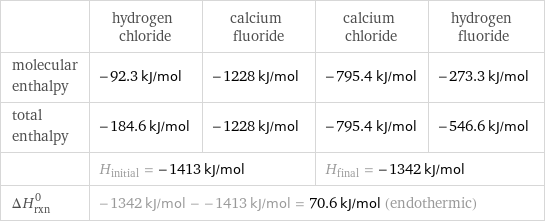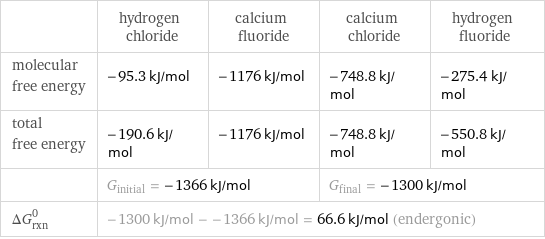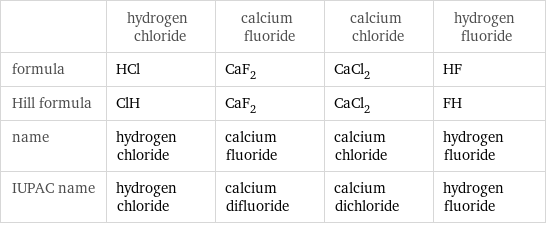Input interpretation

HCl hydrogen chloride + CaF_2 calcium fluoride ⟶ CaCl_2 calcium chloride + HF hydrogen fluoride
Balanced equation

Balance the chemical equation algebraically: HCl + CaF_2 ⟶ CaCl_2 + HF Add stoichiometric coefficients, c_i, to the reactants and products: c_1 HCl + c_2 CaF_2 ⟶ c_3 CaCl_2 + c_4 HF Set the number of atoms in the reactants equal to the number of atoms in the products for Cl, H, Ca and F: Cl: | c_1 = 2 c_3 H: | c_1 = c_4 Ca: | c_2 = c_3 F: | 2 c_2 = c_4 Since the coefficients are relative quantities and underdetermined, choose a coefficient to set arbitrarily. To keep the coefficients small, the arbitrary value is ordinarily one. For instance, set c_2 = 1 and solve the system of equations for the remaining coefficients: c_1 = 2 c_2 = 1 c_3 = 1 c_4 = 2 Substitute the coefficients into the chemical reaction to obtain the balanced equation: Answer: | | 2 HCl + CaF_2 ⟶ CaCl_2 + 2 HF
Structures

+ ⟶ +
Names

hydrogen chloride + calcium fluoride ⟶ calcium chloride + hydrogen fluoride
Reaction thermodynamics
Enthalpy

| hydrogen chloride | calcium fluoride | calcium chloride | hydrogen fluoride molecular enthalpy | -92.3 kJ/mol | -1228 kJ/mol | -795.4 kJ/mol | -273.3 kJ/mol total enthalpy | -184.6 kJ/mol | -1228 kJ/mol | -795.4 kJ/mol | -546.6 kJ/mol | H_initial = -1413 kJ/mol | | H_final = -1342 kJ/mol | ΔH_rxn^0 | -1342 kJ/mol - -1413 kJ/mol = 70.6 kJ/mol (endothermic) | | |
Gibbs free energy

| hydrogen chloride | calcium fluoride | calcium chloride | hydrogen fluoride molecular free energy | -95.3 kJ/mol | -1176 kJ/mol | -748.8 kJ/mol | -275.4 kJ/mol total free energy | -190.6 kJ/mol | -1176 kJ/mol | -748.8 kJ/mol | -550.8 kJ/mol | G_initial = -1366 kJ/mol | | G_final = -1300 kJ/mol | ΔG_rxn^0 | -1300 kJ/mol - -1366 kJ/mol = 66.6 kJ/mol (endergonic) | | |
Equilibrium constant
![Construct the equilibrium constant, K, expression for: HCl + CaF_2 ⟶ CaCl_2 + HF Plan: • Balance the chemical equation. • Determine the stoichiometric numbers. • Assemble the activity expression for each chemical species. • Use the activity expressions to build the equilibrium constant expression. Write the balanced chemical equation: 2 HCl + CaF_2 ⟶ CaCl_2 + 2 HF Assign stoichiometric numbers, ν_i, using the stoichiometric coefficients, c_i, from the balanced chemical equation in the following manner: ν_i = -c_i for reactants and ν_i = c_i for products: chemical species | c_i | ν_i HCl | 2 | -2 CaF_2 | 1 | -1 CaCl_2 | 1 | 1 HF | 2 | 2 Assemble the activity expressions accounting for the state of matter and ν_i: chemical species | c_i | ν_i | activity expression HCl | 2 | -2 | ([HCl])^(-2) CaF_2 | 1 | -1 | ([CaF2])^(-1) CaCl_2 | 1 | 1 | [CaCl2] HF | 2 | 2 | ([HF])^2 The equilibrium constant symbol in the concentration basis is: K_c Mulitply the activity expressions to arrive at the K_c expression: Answer: | | K_c = ([HCl])^(-2) ([CaF2])^(-1) [CaCl2] ([HF])^2 = ([CaCl2] ([HF])^2)/(([HCl])^2 [CaF2])](../image_source/daf0134df7846eb4ea87a940911174e0.png)
Construct the equilibrium constant, K, expression for: HCl + CaF_2 ⟶ CaCl_2 + HF Plan: • Balance the chemical equation. • Determine the stoichiometric numbers. • Assemble the activity expression for each chemical species. • Use the activity expressions to build the equilibrium constant expression. Write the balanced chemical equation: 2 HCl + CaF_2 ⟶ CaCl_2 + 2 HF Assign stoichiometric numbers, ν_i, using the stoichiometric coefficients, c_i, from the balanced chemical equation in the following manner: ν_i = -c_i for reactants and ν_i = c_i for products: chemical species | c_i | ν_i HCl | 2 | -2 CaF_2 | 1 | -1 CaCl_2 | 1 | 1 HF | 2 | 2 Assemble the activity expressions accounting for the state of matter and ν_i: chemical species | c_i | ν_i | activity expression HCl | 2 | -2 | ([HCl])^(-2) CaF_2 | 1 | -1 | ([CaF2])^(-1) CaCl_2 | 1 | 1 | [CaCl2] HF | 2 | 2 | ([HF])^2 The equilibrium constant symbol in the concentration basis is: K_c Mulitply the activity expressions to arrive at the K_c expression: Answer: | | K_c = ([HCl])^(-2) ([CaF2])^(-1) [CaCl2] ([HF])^2 = ([CaCl2] ([HF])^2)/(([HCl])^2 [CaF2])
Rate of reaction
![Construct the rate of reaction expression for: HCl + CaF_2 ⟶ CaCl_2 + HF Plan: • Balance the chemical equation. • Determine the stoichiometric numbers. • Assemble the rate term for each chemical species. • Write the rate of reaction expression. Write the balanced chemical equation: 2 HCl + CaF_2 ⟶ CaCl_2 + 2 HF Assign stoichiometric numbers, ν_i, using the stoichiometric coefficients, c_i, from the balanced chemical equation in the following manner: ν_i = -c_i for reactants and ν_i = c_i for products: chemical species | c_i | ν_i HCl | 2 | -2 CaF_2 | 1 | -1 CaCl_2 | 1 | 1 HF | 2 | 2 The rate term for each chemical species, B_i, is 1/ν_i(Δ[B_i])/(Δt) where [B_i] is the amount concentration and t is time: chemical species | c_i | ν_i | rate term HCl | 2 | -2 | -1/2 (Δ[HCl])/(Δt) CaF_2 | 1 | -1 | -(Δ[CaF2])/(Δt) CaCl_2 | 1 | 1 | (Δ[CaCl2])/(Δt) HF | 2 | 2 | 1/2 (Δ[HF])/(Δt) (for infinitesimal rate of change, replace Δ with d) Set the rate terms equal to each other to arrive at the rate expression: Answer: | | rate = -1/2 (Δ[HCl])/(Δt) = -(Δ[CaF2])/(Δt) = (Δ[CaCl2])/(Δt) = 1/2 (Δ[HF])/(Δt) (assuming constant volume and no accumulation of intermediates or side products)](../image_source/bd3db41069c04b790ae4ae8b35fdc6da.png)
Construct the rate of reaction expression for: HCl + CaF_2 ⟶ CaCl_2 + HF Plan: • Balance the chemical equation. • Determine the stoichiometric numbers. • Assemble the rate term for each chemical species. • Write the rate of reaction expression. Write the balanced chemical equation: 2 HCl + CaF_2 ⟶ CaCl_2 + 2 HF Assign stoichiometric numbers, ν_i, using the stoichiometric coefficients, c_i, from the balanced chemical equation in the following manner: ν_i = -c_i for reactants and ν_i = c_i for products: chemical species | c_i | ν_i HCl | 2 | -2 CaF_2 | 1 | -1 CaCl_2 | 1 | 1 HF | 2 | 2 The rate term for each chemical species, B_i, is 1/ν_i(Δ[B_i])/(Δt) where [B_i] is the amount concentration and t is time: chemical species | c_i | ν_i | rate term HCl | 2 | -2 | -1/2 (Δ[HCl])/(Δt) CaF_2 | 1 | -1 | -(Δ[CaF2])/(Δt) CaCl_2 | 1 | 1 | (Δ[CaCl2])/(Δt) HF | 2 | 2 | 1/2 (Δ[HF])/(Δt) (for infinitesimal rate of change, replace Δ with d) Set the rate terms equal to each other to arrive at the rate expression: Answer: | | rate = -1/2 (Δ[HCl])/(Δt) = -(Δ[CaF2])/(Δt) = (Δ[CaCl2])/(Δt) = 1/2 (Δ[HF])/(Δt) (assuming constant volume and no accumulation of intermediates or side products)
Chemical names and formulas

| hydrogen chloride | calcium fluoride | calcium chloride | hydrogen fluoride formula | HCl | CaF_2 | CaCl_2 | HF Hill formula | ClH | CaF_2 | CaCl_2 | FH name | hydrogen chloride | calcium fluoride | calcium chloride | hydrogen fluoride IUPAC name | hydrogen chloride | calcium difluoride | calcium dichloride | hydrogen fluoride
Substance properties

| hydrogen chloride | calcium fluoride | calcium chloride | hydrogen fluoride molar mass | 36.46 g/mol | 78.075 g/mol | 111 g/mol | 20.006 g/mol phase | gas (at STP) | solid (at STP) | solid (at STP) | gas (at STP) melting point | -114.17 °C | 1418 °C | 772 °C | -83.36 °C boiling point | -85 °C | 2500 °C | | 19.5 °C density | 0.00149 g/cm^3 (at 25 °C) | 3.18 g/cm^3 | 2.15 g/cm^3 | 8.18×10^-4 g/cm^3 (at 25 °C) solubility in water | miscible | | soluble | miscible dynamic viscosity | | | | 1.2571×10^-5 Pa s (at 20 °C)
Units
